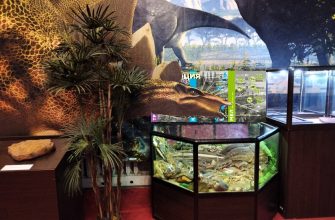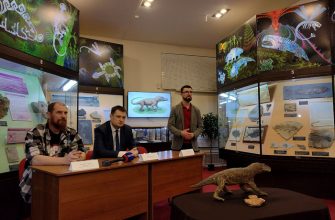A.U.Khlyupin
Annual field research of the Kotelnich Palaeontological Museum at the Kotelnich locality allow the recovery of skeletal remains of ancient animals and permit their placement within the proper geological context. Since 1992 this work has been international one as palaeontologists and geologists from all over the world participate.
The field work begins in May-June, after spring floods abate and the bone bearing horizons, situated near the water, are available for survey clear of scree and litter.
First searches determine fossil locations and identify where erosion poses an immediate danger to skeletons of pareiasaurus and smaller animals.
These places are fixed on the large-scale plan of the geological section. The bones are then processed by glue to prevent their destruction. Exploratory walks lasting for many days help to determine a plan for the following summer’s field work. Some especially valuable finds have to be retrieved from the rock immediately; they are taken out protected with glue and plaster bandages.
In July-August the expedition base is established in the area of the largest concentration of recoverable specimens. To find the remains of small animals such as Therocephalia, much time is needed. That’s why the part of the bank where excavations are done is thoroughly examined every day over the field season.
To extract large fossils, for example, a skeleton of Pareiasaurus, 7 to 10 days is needed, depending on the weather. At first, the place of the find is careful studied, and the pieces of bones which were taken far away during spring flood are picked up. After that the upper layer of the rock is opened with picks and spades. Then the big block of rock containing the skeleton is cleaned, from the and sides. The rock and bones in it are regularly impregnated with glue. After the glue has set and the rock has dried out for a good depth the block of rock is carefully taken in big pieces, which are marked by numbers. An assembly draft is drawn for correct reassembly in a laboratory.
If the find is very delicate or if its raining the block is removed whole. The plaster jacket is made to secure the fossil. Sometimes its weight is some hundreds of kilograms. The other work is done in the laboratory.
At the end of the field season time is spent in a laboratory processing the material found in the summer. Using natural fractures the blocks are reduced to smaller pieces, which are reassembled after adjustment and cleaning. After that the superfluous rock is removed from the bones using electric and pneumatic instruments. Finer preparation is done by hand using thin needles. During preparation bones and rock around them are impregnated with glue, preventing their further destruction.
In the most cases it is not necessary to remove the bones from the rock completely. Its enough to clean them from the top and from the sides to see them well. In such condition the fossils can be studied, they can be displayed on exhibition, and it’s easy to make casts from them. It’s more difficult to prepare [volumetric] finds, for example skulls, when it’s necessary to point all structure details of a fossil in and outside. Additionally, this material is more difficult to preserve after preparation.
Each professional preparator has his own technique; his work is easy to identify by his style. Every fossil needs an individual approach, and mistakes are inadmissible, because it’s impossible to recover the lost.
All the work complex connected with discovery and preparation is made by the collaborators of the Kotelnich Regional Palaeontological Museum.






